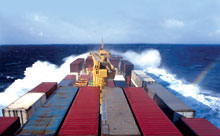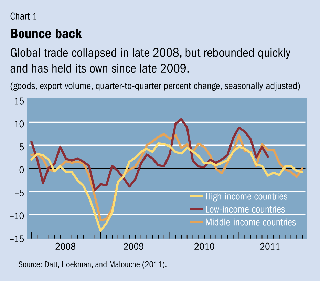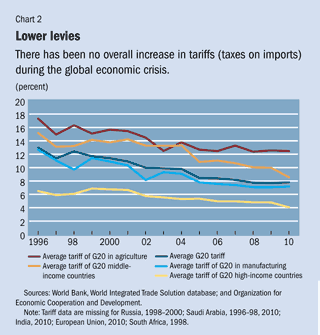Trade Policy: So Far So Good?
Finance & Development, June 2012, Vol. 49, No. 2
There was no widespread resort to protectionism during the global crisis but there have been recent moves in that direction

THE sharp collapse in international trade between the second quarter of 2008 and the third quarter of 2009 was the steepest decline ever recorded, even sharper than during the Great Depression of the 1930s. But unlike in the Great Depression, during the 2008 global economic crisis and its recessionary aftermath there was no widespread resort to protectionism by countries seeking to shield their industries at the expense of their neighbors.
Instead, monetary and fiscal stimulus programs—including support for specific industries such as automobile manufacturing—helped demand recover and led global trade to bounce back rapidly (see Chart 1). Chief among the factors that help explain both the depth of the collapse in trade and the rapid recovery are the international supply chains—which link many countries together in the production process and have been supported by the steady liberalization of trade in the past few decades. The emergence of a multipolar world economy, with demand in major emerging markets, especially China, helped revive trade.

But even if the overall level of protection did not increase substantially during 2008–11, many measures were imposed that discriminate against foreign suppliers, and there is evidence that protectionist pressures are growing, in part in response to appreciating real exchange rates in commodity-exporting nations and concerns regarding the impact of monetary expansion by advanced economies.
Active use of trade policy
Developing economies, especially larger emerging markets, were among the most active users of trade policy. According to monitoring reports issued by the World Trade Organization (WTO), 1,243 trade measures were imposed between the onset of the crisis in late 2008 and the end of the fourth quarter of 2011. About three-quarters of these restricted trade, while one-quarter reduced the level of import protection. The Global Trade Alert (GTA), a network of think tanks and institutes that collect information on trade measures, covers a larger spectrum of actions that may affect trade and reports 1,593 actions between November 2008 and November 2011, of which 1,187 discriminated against foreign suppliers and 406 were liberalizing. Policies were not monitored comprehensively prior to 2008, making it impossible to say to what extent these measures constitute an overall increase in trade policy activism.
The number of new protectionist actions peaked in the first quarter of 2009 and bottomed in the third quarter of 2010. However, recent GTA data suggest that protectionist measures are increasing again; protectionist actions in the third quarter of 2011 alone were as high as in the worst periods of 2009 (Evenett, 2011).
The Group of 20 (G20) advanced and emerging economies account for most of the trade measures, most of which did not involve tariffs, imposed since 2008. There has been no significant increase in the overall use of tariffs or temporary trade barriers, such as antidumping measures, aimed at assisting local firms injured by import competition (Bown, 2011). Such measures affected only about 2 percent of world trade (Kee, Neagu, and Nicita, 2010; WTO, 2011). The trend of gradual tariff liberalization observed since the mid-1990s has not been affected (see Chart 2).

Although the overall incidence of tariff measures has been limited, many countries have used nontariff measures, such as restrictive import licensing and local content requirements, that may have a greater impact. Henn and McDonald (2011) conclude that trade flows affected by restrictions decreased by between 5 and 8 percent relative to trade flows of the same product among partners unaffected by protectionist measures. At the same time, many countries undertook liberalizing trade policies and general fiscal and monetary stimulus measures that helped generate demand for imports.
Changes in responses
Countries can be grouped into trade policy activists and those that refrained from using trade policies. Active users—including such major countries as Brazil, China, and India—tend to pursue a mix of trade-restricting and trade-liberalizing actions. This helps explain why there was no significant overall net increase in levels of border protection and only a small overall impact on global trade. Instead of traditional trade policy instruments, major advanced economies such as those in the European Union and the United States relied much more on providing financial support to domestic industries. Because such support targets domestic firms, it can have a protectionist effect. The size of the associated distortions to international competition is not known, however. The extent of such support measures is much smaller today than it was immediately following the onset of the global economic crisis.
Production of manufactured goods is increasingly organized through global chains, with goods processed (value added) in multiple countries that are part of the chain. Plants in each country specialize in a specific process that culminates in a final product. This overall process, often called vertical specialization, means that a significant share of the price of an export likely reflects the value of a product’s imported inputs. For the world as a whole, the import content of exports has been estimated to be about 30 percent (Daudin, Rifflart, and Schweisguth, 2011).
Gawande, Hoekman, and Cui (2011) show that the intensity of vertical specialization helps explain the stable or declining tariffs in 2009:
• Higher tariffs are a tax on downstream processing parts of the chain, so importing governments have an incentive to keep tariffs low.
• Trading partners want countries producing the inputs they use to keep trade costs low—including through low or zero tariffs. This benefits the exporting countries that are further down the chain and those that produce the inputs through higher overall exports (sales of the final product).
• Countries that are members of deep free trade agreements—such as Mexico (the North American Free Trade Agreement) and Turkey (a customs union with the European Union)—or that have bound their tariffs in the WTO, such as China, were much more constrained in their use of tariffs than were other countries.
These findings do not mean that governments do not face pressure to assist domestic firms and industries. What they do mean is that incentives to use traditional trade policies such as tariffs differ across countries and regions. Some parts of the world—Europe, North America, and much of east Asia—are so interconnected and integrated that trade policy no longer is a very useful tool to assist domestic industries, even in the face of a massive external demand shock. This also explains the widespread use of financial support measures in the European Union and United States. But other regions—parts of Latin America and sub-Saharan Africa—are much less integrated into international value chains, so their governments may support the use of trade policy instruments to shelter domestic industries from foreign competition.
Cloudy horizon
There are two clouds on the trade policy horizon. The first is the increasing use of measures to protect manufacturing activities in countries such as Brazil that are less integrated into global value chains and that have experienced appreciating real exchange rates. The second is the increasing prevalence of measures to restrict the exports of agricultural products and natural resources—which hurts trading partners. In both cases governments tend to use nontariff measures—such as subsidies, import and export bans, discriminatory public procurement policies, and increased licensing or product inspection requirements—which are generally less transparent than tariffs and often generate greater distortions.
WTO and GTA data suggest that a little less than half of all nontariff measures imposed since 2008 are quantitative. About one-third have been imposed on exports (WTO, 2011). The objective of such measures is generally to lower domestic prices to the benefit of households (in the case of food products) and local industries that process the materials. China, for example, has imposed restrictions on exports of certain minerals and raw materials.
The number of “buy national” measures (including local content and national preference incentives) increased significantly in 2011, especially in emerging market G20 members. Russia, for example, has imposed import quotas and local content requirements on food items and automobiles. Brazil increased taxes on motor vehicles with less than 65 percent local content that do not originate in Mercosur (Brazil’s common market with Argentina, Paraguay, and Uruguay). Brazil also recently renegotiated a trade agreement with Mexico to impose a quota on the value of permitted exports of cars to Brazil for a three-year period and has indicated that it may raise tariffs on selected products. Argentina has increased the use of nonautomatic import licensing, a process under which import approvals are discretionary. (WTO rules require a decision within 60 days.) Argentina also introduced reference prices for many imported products and now conditions import authorization for some goods on offsetting exports. Indonesia also introduced nonautomatic licensing requirements for imports of household appliances, textiles, footwear, and certain food products, some of which may be imported only through designated seaports.
The recent trend is worrisome. Protectionist measures divert attention from the underlying local cost factors that make it difficult for industries to compete, and prevent rather than support vertical specialization, which has proven to be a driver of growth in east Asia, eastern Europe, and Mexico. Although the pressures generating protectionist actions in a number of emerging markets are in part the result of macroeconomic policies implemented by other countries, raising the level of trade protection will hurt both the countries that impose the measures and their trading partners, reducing growth prospects overall at a time when the world economy needs to generate and sustain higher growth.■
This article draws on “Taking Stock of Trade Protectionism Since 2008,” by Mohini Datt, Bernard Hoekman, and Mariem Malouche, published by the World Bank in the December 2011 issue of Economic Premise.
References
Bown, Chad, ed., 2011, The Great Recession and Import Protection: The Role of Temporary Trade Barriers (Washington: Center for Economic Policy Research and World Bank). See also www.voxeu.org/index.php?q=node/6914
Daudin, Guillaume, Christine Rifflart, and Danielle Schweisguth, 2011, “Who Produces for Whom in the World Economy?” Canadian Journal of Economics, Vol. 44, No. 4, pp. 1403–37.
Evenett, Simon, 2011, Resolve Falters as Global Prospects Weaken: The 9th GTA Report (London: Center for Economic Policy Research).
Gawande, Kishore, Bernard Hoekman, and Yue Cui, 2011, “Determinants of Trade Policy Responses to the 2008 Financial Crisis,” Policy Research Working Paper 5862 (Washington: World Bank).
Henn, Christian, and Brad McDonald, 2011, “Protectionist Responses to the Crisis: Damage Observed in Product-Level Trade,” IMF Working Paper 11/139 (Washington: International Monetary Fund).
Kee, Hiau Looi, Cristina Neagu, and Alessandro Nicita, 2010, “Is protectionism on the Rise? Assessing National Trade Policies during the Crisis of 2008,” Policy Research Working Paper 5274 (Washington: World Bank).
World Trade Organization (WTO), 2011, Report on G-20 Trade Measures (Geneva).


